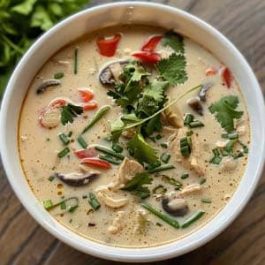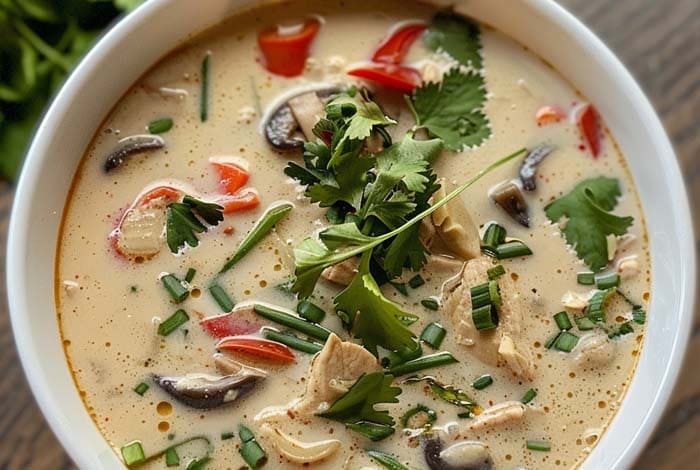Introduction to Tom Kha Gai
Tom Kha Gai, a staple in Thai cuisine, epitomizes the harmonious blend of flavors that Thai food is renowned for. This coconut chicken soup, whose name directly translates to “chicken galangal soup,” marries the richness of coconut milk with the aromatic sharpness of galangal, a root similar to ginger but with a distinctively earthy and citrusy flavor. The soup’s history, while not documented extensively, is deeply rooted in Thai culinary traditions, reflecting the local ingredients readily available in Thailand’s tropical climate. Lemongrass, kaffir lime leaves, and Thai chilies add layers of complexity to the broth, making it a quintessential example of Thai gastronomy’s ability to balance the five fundamental tastes: sweet, sour, salty, bitter, and umami.
Culturally, Tom Kha Gai is more than just a soup; it’s a reflection of Thai society’s emphasis on communal eating and the importance of food as a means to bring people together. In Thailand, meals are often shared, and dishes like Tom Kha Gai are placed at the center of the table, inviting everyone to partake. This practice underscores the social aspect of eating, where food is a medium for conversation, connection, and community.
What Makes Tom Kha Gai Unique?
Compared to other Thai soups, such as the fiery Tom Yum Goong, Tom Kha Gai stands out for its creamy texture and subtle complexity. While both soups share some common ingredients like lemongrass and galangal, Tom Kha Gai distinguishes itself with the addition of coconut milk. This ingredient not only tempers the spice but also adds a richness that absorbs and melds the various flavors present. The result is a soup that is both invigorating and comforting, capable of warming the soul without overwhelming the palate with heat.
The distinctive ingredients of Tom Kha Gai—galangal, coconut milk, lemongrass, and kaffir lime leaves—each play a pivotal role in creating its unique flavor profile. Galangal contributes a sharp, medicinal quality that is balanced by the sweetness of the coconut milk. Lemongrass and kaffir lime leaves infuse the soup with citrusy notes, cutting through the creaminess and refreshing the palate. Together, these flavors create a culinary symphony that is distinctly Thai, showcasing the country’s rich heritage and the depth of its food culture.
Key Ingredients
The essence of Tom Kha Gai lies in its unique blend of ingredients, each contributing to the soup’s distinctive taste. The primary components include:
- Chicken: Typically, boneless pieces are used for ease of eating, but bones can add depth to the broth’s flavor.
- Coconut Milk: The base that gives the soup its creamy texture and subtle sweetness. Full-fat versions are preferred for a richer taste.
- Galangal: A key spice that distinguishes this soup with its sharp, citrusy flavor. While galangal is ideal, ginger can be used as an alternative, albeit with a different flavor profile.
- Lemongrass: Adds a lemony scent and freshness to the soup. If unavailable, lemon zest can serve as a makeshift substitute.
- Kaffir Lime Leaves: Imparts a uniquely Thai citrus aroma. Lime zest combined with a bit of bay leaf can be used if kaffir lime leaves are hard to find.
- Fish Sauce: Provides the salty, umami depth. Soy sauce or tamari are alternatives for vegetarians or those with dietary restrictions.
- Mushrooms: Commonly, straw mushrooms are used, but button mushrooms or oyster mushrooms can also work well.
- Chilies: Thai bird chilies add a kick; however, the amount can be adjusted based on tolerance for heat.
- Lime Juice: Brings a necessary sour component that balances the soup’s flavors.
Preparation of Ingredients
Preparing the ingredients properly is crucial for achieving the authentic taste of Tom Kha Gai. Begin by slicing the chicken into bite-sized pieces, allowing for quicker cooking and easier consumption. Galangal and lemongrass should be sliced or smashed to release their flavors into the broth without overpowering the dish, as these elements are traditionally not eaten but left in the soup for their aroma.
Step-by-Step Cooking Guide
- Starting the Broth: Begin by simmering the coconut milk with lemongrass, galangal, and kaffir lime leaves. This initial step infuses the coconut milk with the fragrant aromas of the spices.
- Adding the Chicken: Once the broth is fragrant, add the chicken pieces, ensuring they are submerged and cook evenly. This process should be gentle to keep the chicken tender.
- Incorporating Mushrooms and Other Ingredients: After the chicken is nearly cooked, add the mushrooms and let them soften. This is also the time to add the fish sauce and sugar, adjusting these elements to taste.
- Finishing Touches: Just before serving, remove the soup from heat and stir in the lime juice. This preserves its vibrant tanginess. Garnish with fresh cilantro, chili slices, and additional lime wedges on the side for individual seasoning.
Variations: For vegetarians or vegans, substitute the chicken with tofu and use vegetable broth in place of chicken broth. A vegetarian fish sauce or soy sauce can replace traditional fish sauce to maintain the umami flavor.
This guide, sourced from insights across various recipes, provides a foundation for creating a comforting bowl of Tom Kha Gai. Whether sticking to tradition or adapting to dietary needs, the balance of sour, sweet, salty, and spicy can be tailored to personal preference, ensuring a delightful culinary experience.
Health Benefits
Tom Kha Gai is not just beloved for its taste; it also boasts a nutritional profile that contributes to health and well-being. This soup is relatively low in calories yet rich in essential nutrients, making it a guilt-free addition to any diet. Key ingredients like galangal, lemongrass, and coconut milk are sources of antioxidants and have anti-inflammatory properties. Galangal, similar to ginger, contains compounds that may reduce inflammation and increase antioxidant capacity in the body. Lemongrass has been shown to have antioxidant properties, helping to neutralize damaging free radicals. Coconut milk, rich in medium-chain triglycerides (MCTs), supports heart health and weight maintenance. Together, these ingredients create a dish that supports immune health, reduces inflammation, and can contribute to a balanced diet.
Dietary Adaptations
To make Tom Kha Gai suitable for a variety of dietary needs, several adaptations can be made without compromising its iconic flavor. For a vegan version, replace the chicken with tofu or mushrooms to maintain the protein content and use vegetable broth instead of chicken broth. To ensure the dish is gluten-free, opt for tamari or a gluten-free soy sauce instead of traditional fish sauce, which may contain gluten. Additionally, for those watching their fat intake, light coconut milk can be used as a substitute for full-fat coconut milk, though this will slightly alter the soup’s richness. These adjustments make Tom Kha Gai accessible to everyone, allowing more people to enjoy this flavorful, nutritious Thai classic while adhering to their dietary preferences and restrictions.
How to Serve Tom Kha Gai
Traditionally, Tom Kha Gai is served hot as a main course or an appetizer, often in a communal pot at the center of the table, allowing everyone to share. It is typically enjoyed with a side of steamed jasmine rice or sticky rice, which helps to absorb the soup’s rich flavors and provides a comforting balance to the spicy and sour notes of the dish. The soup is garnished with fresh cilantro, a squeeze of lime juice, and additional chili slices for those who prefer an extra kick. This manner of serving not only enhances the dish’s flavors but also embodies the Thai culture of sharing and community at the dining table.
Innovative Serving Ideas
For a creative twist, Tom Kha Gai can be transformed into a base for noodle soups or poured over a bowl of fresh, crunchy vegetables for a deconstructed soup salad. Another innovative idea is to reduce the broth and serve it as a sauce over grilled chicken, combining the soup’s essence with a barbecue flair. These modern takes on the traditional soup allow for flexibility in presentation and consumption, making Tom Kha Gai a versatile dish that can be adapted for various occasions and dietary preferences.
FAQs
- Can Tom Kha Gai be made vegetarian?
- Yes, by substituting chicken with tofu and using vegetable broth, the soup can be easily adapted for vegetarians.
- Is it possible to make Tom Kha Gai without galangal?
- While galangal offers a unique flavor, ginger can be used as a substitute, though the taste will differ slightly.
- Can the soup be frozen for later use?
- Tom Kha Gai can be frozen, but it’s best to do so without the coconut milk, as its texture may change upon reheating. Add fresh coconut milk when reheating the soup.
- How can I adjust the spiciness of the soup?
- The spiciness can be adjusted by varying the amount of Thai chilies used. For less heat, remove the seeds or reduce the number of chilies.
- What are the best mushrooms to use in Tom Kha Gai?
- Straw or button mushrooms are traditionally used, but oyster or shiitake mushrooms also make tasty alternatives.
- Is Tom Kha Gai healthy?
- Yes, the soup is rich in vitamins and minerals from its various ingredients like lemongrass and galangal, and it can be made more health-conscious by adjusting the coconut milk and chicken portions.
These FAQs address some of the most common inquiries regarding the preparation and customization of Tom Kha Gai, highlighting its versatility and the possibility to adapt it to different tastes and dietary needs.

Tom Kha Gai Recipe
Equipment
- Medium-sized pot
- Knife and cutting board
- Measuring cups and spoons
Ingredients
- 1 lb chicken breast thinly sliced
- 2 cans of coconut milk
- 1 stalk of lemongrass cut into pieces and smashed
- 4 slices of galangal
- 6 kaffir lime leaves torn
- 1 cup of mushrooms sliced
- 2 tablespoons fish sauce
- 1 tablespoon sugar
- 2-3 Thai chilies finely chopped (adjust to taste)
- Juice of 2 limes
- Fresh cilantro for garnish
Instructions
- Begin by heating the coconut milk in a pot over medium heat along with the lemongrass, galangal, and kaffir lime leaves.
- Once simmering, add the chicken and mushrooms, cooking until the chicken is done.
- Season with fish sauce and sugar, adjusting to taste.
- Just before serving, remove from heat and add lime juice.
- Garnish with fresh cilantro and serve hot with jasmine rice or as is.
Notes
- Galangal and lemongrass are essential for the authentic flavor, but ginger can be substituted if galangal is not available.
- For a vegetarian version, substitute chicken with tofu and use vegetable broth.
- Adjust the amount of chilies based on your preference for heat.
- The soup can be stored in the fridge for up to 3 days. Reheat gently to avoid separating the coconut milk.

